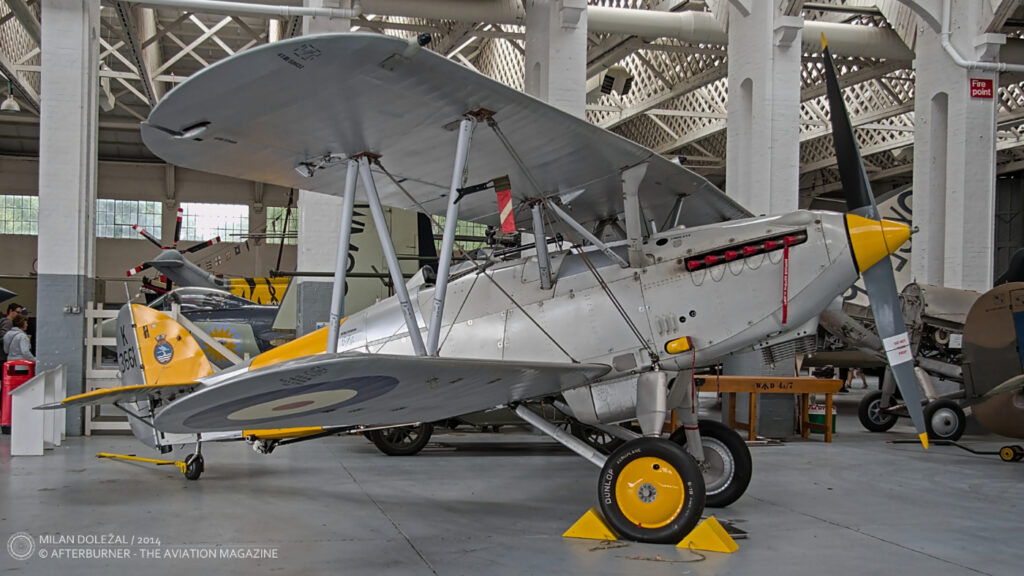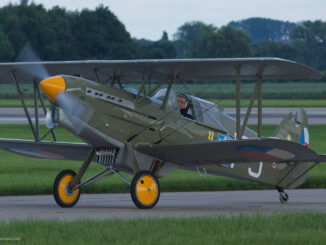 Hawker Nimrod II (c/n 41H-59890, formerly K3661 of the Fleet Air Arm), exhibited at Hangar 2 of the Imperial War Museum Duxford, June 2014.
Hawker Nimrod II (c/n 41H-59890, formerly K3661 of the Fleet Air Arm), exhibited at Hangar 2 of the Imperial War Museum Duxford, June 2014.
In the middle of 1920s, the Air Ministry began to look for a successor to Fairey Flycatcher, at the time basic carrier-borne fighter aircraft of the Fleet Air Arm (FAA). Therefore, specification N.21/26 for a new naval fighter was issued in 1926 and aroused interest of many aviation manufacturers. Projects of the new aeroplane were submitted by Armstrong Whitworth, Blackburn, Fairey, Gloster, Hawker, Parnall and Vickers.
The flying trials were carried out in 1928, however none of designs proposed by the abovementioned companies was approved for serial production. Instead, the Navy authorities were willing to focus on Hawker Hoopoe, an aircraft that was not following the N.21/26 specification and was developed by Hawker as private venture.
The Hoopoe was an open-cockpit, single seat biplane with fixed undercarriage, powered by Armstrong Siddeley Panther radial engine. And it was exactly the engine that attracted the Navy´s interest, as at the time the radial types were the most preferred for naval fighters.
And then, the chief designer of Hawker, Sydney Camm, went up on the stage. It was just a couple of months after Camm´s successful development of a series of new aircraft for the Royal Air Force, such as Hart, Hornet and Firefly II. In addition, he was in the final stage of creating another famous fighter biplane, Hawker Fury.
In a quite short time, Camm managed to convince the Navy authorities that the future naval fighter should be powered by inline engine. Moreover, its construction could be based on the already developed Fury and its design. Therefore, the Air Ministry issued new specification 16/30 that was tailored for only one naval fighter – the one Camm had just began to develop.
The new naval fighter, initially designated Norn, was indeed very similar to the Fury. It was a single seat biplane with open cockpit and fixed undercarriage. The aeroplane was powered by 477 hp Rolls-Royce Kestrel inline piston engine. Still made as the Hawker company private venture, the Norm prototype was successfully flown in 1930.
After a series of test flights, the Navy approved Camm´s design for the naval fighter and bought the prototype for official evaluation with the FAA. However, the Navy asked for some additional modifications to the airframe and finally the redeveloped aircraft was officially re-named Nimrod.
On 14th October 1931, prototype of the Nimrod successfully completed its maiden flight. Shortly after, the serial manufacturing of Camm-designed naval fighter began. The first production series – later known as the Nimrod I – was split in three batches of 11, 24 and 19 aeroplanes, respectively.
Drawing on the experiences from the Nimrod I service, Sydney Camm made several upgrades to his initial design. Changes included slightly swept upper and lower wings, arrestor hook and more powerful powerplants – Kestrel VFp or IIS engines, generating 525 or 608 hp, respectively. The modified aeroplane was designated Nimrod II and first examples were delivered to the FAA in March of 1933. A total number of twenty-seven examples of Nimrod II aircraft was built.
The Hawker Nimrod remained in operational service with the FAA until May of 1939, when in was succeeded by Gloster Sea Gladiator. The biplane was then transferred to training units, where it stayed until 1941.
Apart from the FAA, the only other operator of the Nimrod was the Royal Danish Navy Aviation (Marinens Flyvevæsen). Denmark bought two aeroplanes from Hawker and another ten were built locally under license. In Danish service, the naval biplane was named Nimrødderne and stayed in active duty until 1940, when Germany invaded Denmark.
Single examples of the Nimrod were acquired for evaluation purposes by Portuguese and Japanese navies but without any further purchases.
The aircraft K3661 featured within our Photo of the Week series is one of only two surviving Nimrods and the sole representative of the Nimrod II type. The aeroplane was retired in 1939 and put into storage – so effectively that its remains were discovered only in 1972. Then, it was restored and donated to the RAF Museum in Henlow.
In 1992, restoration of the aircraft to airworthy condition was launched. After long and tough work, the K3661 performed its second maiden flight in November of 2006. The aircraft is currently a part of the Fighter Collection in Duxford, being also exhibited in Hangar 2 of the Imperial War Museum Duxford.



